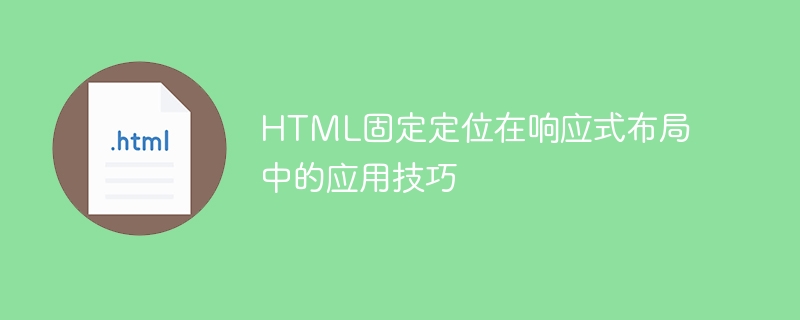 Web Front-end
Web Front-end
 HTML Tutorial
HTML Tutorial
 Practical tips for using HTML fixed positioning in responsive layouts
Practical tips for using HTML fixed positioning in responsive layouts
Practical tips for using HTML fixed positioning in responsive layouts

The application skills of HTML fixed positioning in responsive layout require specific code examples
With the popularity of mobile devices and the increasing user demand for responsive layout, Developers face more challenges in web design. One of the key issues is how to implement fixed positioning to ensure that elements can be fixed at specific locations on the page under different screen sizes. This article will introduce the application skills of HTML fixed positioning in responsive layout and provide specific code examples.
Fixed positioning in HTML is achieved through the position attribute of CSS. When doing responsive layout, we usually use media queries to apply different styles according to different screen sizes. The following are some commonly used application techniques and corresponding code examples in HTML fixed positioning:
- Fixed top navigation bar
Fixed top navigation bar is very useful in responsive layouts Common, allowing users to always easily navigate to other pages when scrolling. Here is a simple example:
HTML code:
<nav class="fixed-top">
<ul>
<li><a href="#">首页</a></li>
<li><a href="#">产品</a></li>
<li><a href="#">关于</a></li>
<li><a href="#">联系</a></li>
</ul>
</nav>CSS code:
.fixed-top {
position: fixed;
top: 0;
left: 0;
width: 100%;
background-color: #fff;
z-index: 9999;
}- Fixed bottom copyright information
Fixed Bottom copyright information usually appears at the bottom of the page in responsive layouts, ensuring that the information is displayed stably on any screen size. Here is a simple example:
HTML code:
<footer class="fixed-bottom"> <p>版权所有 © 2021</p> </footer>
CSS code:
.fixed-bottom {
position: fixed;
bottom: 0;
left: 0;
width: 100%;
background-color: #f0f0f0;
padding: 10px;
text-align: center;
}- Fixed sidebar
Fixed Sidebars are a common layout method that keeps navigation menus or other important information visible as the page scrolls. Here is a simple example:
HTML code:
<div class="sidebar">
<ul>
<li><a href="#">首页</a></li>
<li><a href="#">产品</a></li>
<li><a href="#">关于</a></li>
<li><a href="#">联系</a></li>
</ul>
</div>CSS code:
.sidebar {
position: fixed;
top: 50%;
left: 0;
transform: translate(0, -50%);
background-color: #f0f0f0;
padding: 10px;
}- Fixed popup
Fixed popup Boxes are often used in responsive layouts to display important notifications or prompts. The following is a simple example:
HTML code:
<div class="modal"> <h2 id="重要提示">重要提示</h2> <p>请在此处输入提示内容。</p> <button>关闭</button> </div>
CSS code:
.modal {
position: fixed;
top: 50%;
left: 50%;
transform: translate(-50%, -50%);
background-color: #fff;
padding: 20px;
box-shadow: 0 0 10px rgba(0, 0, 0, 0.2);
}Through the above code example, we can see that HTML is fixedly positioned in a responsive layout application skills. Using the position attribute and related top, left, bottom, and right attributes, we can easily achieve various fixed positioning effects. However, it should be noted that when designing a responsive layout, the adaptability under different screen sizes should be carefully considered to ensure that the fixed positioning of elements does not affect the usability and user experience of the page.
To sum up, responsive layout is one of the important features of modern web design, and HTML fixed positioning provides creators of responsive layout with greater freedom and creative space. By properly applying HTML fixed positioning techniques, we can provide users with a better browsing experience on different screen sizes.
The above is the detailed content of Practical tips for using HTML fixed positioning in responsive layouts. For more information, please follow other related articles on the PHP Chinese website!

Hot AI Tools

Undresser.AI Undress
AI-powered app for creating realistic nude photos

AI Clothes Remover
Online AI tool for removing clothes from photos.

Undress AI Tool
Undress images for free

Clothoff.io
AI clothes remover

AI Hentai Generator
Generate AI Hentai for free.

Hot Article

Hot Tools

Notepad++7.3.1
Easy-to-use and free code editor

SublimeText3 Chinese version
Chinese version, very easy to use

Zend Studio 13.0.1
Powerful PHP integrated development environment

Dreamweaver CS6
Visual web development tools

SublimeText3 Mac version
God-level code editing software (SublimeText3)

Hot Topics
 1385
1385
 52
52
 Table Border in HTML
Sep 04, 2024 pm 04:49 PM
Table Border in HTML
Sep 04, 2024 pm 04:49 PM
Guide to Table Border in HTML. Here we discuss multiple ways for defining table-border with examples of the Table Border in HTML.
 HTML margin-left
Sep 04, 2024 pm 04:48 PM
HTML margin-left
Sep 04, 2024 pm 04:48 PM
Guide to HTML margin-left. Here we discuss a brief overview on HTML margin-left and its Examples along with its Code Implementation.
 Nested Table in HTML
Sep 04, 2024 pm 04:49 PM
Nested Table in HTML
Sep 04, 2024 pm 04:49 PM
This is a guide to Nested Table in HTML. Here we discuss how to create a table within the table along with the respective examples.
 HTML Table Layout
Sep 04, 2024 pm 04:54 PM
HTML Table Layout
Sep 04, 2024 pm 04:54 PM
Guide to HTML Table Layout. Here we discuss the Values of HTML Table Layout along with the examples and outputs n detail.
 HTML Input Placeholder
Sep 04, 2024 pm 04:54 PM
HTML Input Placeholder
Sep 04, 2024 pm 04:54 PM
Guide to HTML Input Placeholder. Here we discuss the Examples of HTML Input Placeholder along with the codes and outputs.
 HTML Ordered List
Sep 04, 2024 pm 04:43 PM
HTML Ordered List
Sep 04, 2024 pm 04:43 PM
Guide to the HTML Ordered List. Here we also discuss introduction of HTML Ordered list and types along with their example respectively
 Moving Text in HTML
Sep 04, 2024 pm 04:45 PM
Moving Text in HTML
Sep 04, 2024 pm 04:45 PM
Guide to Moving Text in HTML. Here we discuss an introduction, how marquee tag work with syntax and examples to implement.
 HTML onclick Button
Sep 04, 2024 pm 04:49 PM
HTML onclick Button
Sep 04, 2024 pm 04:49 PM
Guide to HTML onclick Button. Here we discuss their introduction, working, examples and onclick Event in various events respectively.




